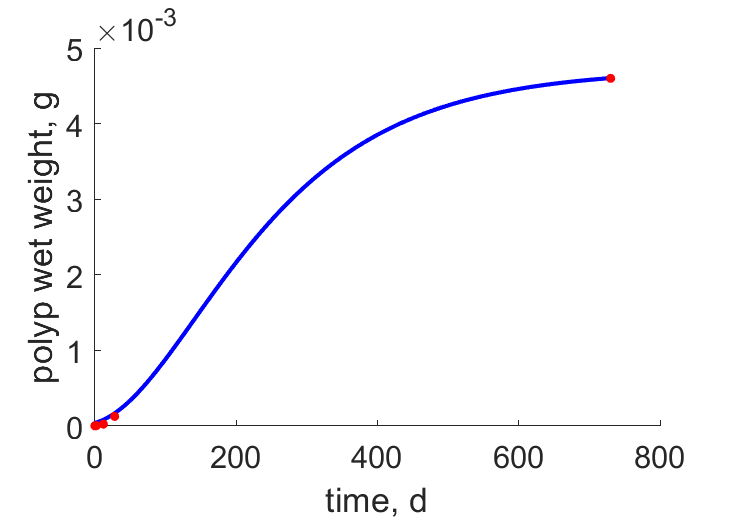Predictions & Data for this entry
| Model: abj | climate: MC | migrate: | phylum: |
| COMPLETE = 2.5 | ecozone: MPN, MAN | food: biPz | class: |
| MRE = 0.043 | habitat: 0iMp, biMb | gender: D | order: |
| SMSE = 0.002 | embryo: Mp | reprod: Aa, Os | family: |
Zero-variate data
| Data | Observed | Predicted | (RE) | Unit | Description | Reference |
|---|---|---|---|---|---|---|
| tp | 30 | 31.13 | (0.03766) | d | time since birth at puberty of the medusae | guess |
| am | 547.5 | 574.8 | (0.04985) | d | life span of the medusae | guess |
| Lb | 0.45 | 0.01082 | (0.976) | cm | bell diameter at birth | HolsSotj2007 |
| Lp | 12 | 11.37 | (0.0523) | cm | bell diameter at puberty | guess |
| Li | 90 | 95.75 | (0.06394) | cm | ultimate bell diameter | Wiki |
| L76 | 30 | 29.07 | (0.03088) | cm | bell diameter at 76 d | HolsSotj2007 |
| Wwb | 5.2e-07 | 5.006e-07 | (0.03725) | g | wet weight at birth | HolsSotj2007 |
| Wwi | 3.5e+05 | 3.473e+05 | (0.007644) | g | ultimate wet weight | Wiki |
| Ni | 7e+11 | 6.852e+11 | (0.02112) | # | cumulated # eggs | guess |
Uni- and bivariate data
| Data | Figure | Independent variable | Dependent variable | (RE) | Reference |
|---|---|---|---|---|---|
| tL |  | time | bell diameter | (0.09081) | HolsSotj2007 |
| tW_p |  | time | polyp wet weight | (0.0379) | HolsSotj2007 |
Pseudo-data at Tref = 20°C
| Data | Generalised animal | Rhizostoma octopus | Unit | Description |
|---|---|---|---|---|
| v | 0.02 | 0.03026 | cm/d | energy conductance |
| p_M | 18 | 25.36 | J/d.cm^3 | vol-spec som maint |
| k_J | 0.002 | 0.002 | 1/d | maturity maint rate coefficient |
| k | 0.3 | 0.04115 | - | maintenance ratio |
| kap | 0.8 | 0.7583 | - | allocation fraction to soma |
| kap_G | 0.8 | 0.8018 | - | growth efficiency |
| kap_R | 0.95 | 0.95 | - | reproduction efficiency |
Discussion
- Polyps are assumed to differ from medusae by {p_Am} and E_Hp only and by isomorphic growth
Facts
- polyps 2.3-24 mm high (including arms); 1-5 ephyrae per strobila; strobilation 24 d at 10 C; (Ref: HolsSotj2007)
- budding of scyphistomae is rare, especially at low temperatures (Ref: HolsSotj2007)
- Newly liberated ephyrae were able to catch and feed on living Artemia nauplii, and within a few days they could swim well in culture dishes (Ref: HolsSotj2007)
- It is a favourite food of the leatherback turtle (Ref: Wiki)
Bibliography